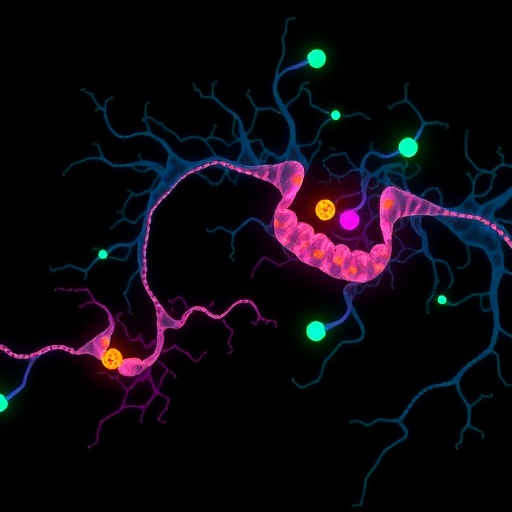In a groundbreaking study soon to be published in Scientific Reports, researchers Xu, Wang, and Wu, along with their team, have unveiled a novel role for long non-coding RNA (lncRNA) RP11-199F11.2 in the context of high-grade serous ovarian cancer (HGSOC). The study primarily investigates how this lncRNA contributes to cancer cell proliferation through a newly identified mechanism involving cuproptosis, a form of cell death emerging as significant in cancer biology. This research not only sheds light on the intricacies of ovarian cancer progression but also paves the way for potential therapeutic interventions targeting this pervasive disease.
High-grade serous ovarian cancer is recognized as one of the deadliest cancers affecting women globally. Despite advances in treatment regimens, including chemotherapy and targeted therapies, the prognosis for patients remains bleak, largely due to late-stage diagnosis and the cancer’s intrinsic ability to develop resistance to treatment. As scientists strive to uncover the molecular pathways driving this malignancy, the role of non-coding RNAs has gained increasing recognition. These molecular players, often ignored in the past, are now positioned as critical regulators of gene expression and cellular processes.
In their research, Xu and colleagues demonstrate that the lncRNA RP11-199F11.2 is markedly overexpressed in HGSOC tissues compared to normal ovarian tissues. This upregulation was confirmed through a series of experiments utilizing quantitative PCR and RNA sequencing techniques. The correlation between RP11-199F11.2 expression levels and tumor aggressiveness lays the groundwork for further exploration into how this lncRNA might influence cancer biology. The team proposes that this overexpression may serve as a biomarker for disease progression and patient stratification.
The connection between RP11-199F11.2 and cuproptosis is particularly noteworthy. Cuproptosis, a form of direct copper-induced cell death, represents a novel angle in cancer research. Unlike apoptosis or necrosis, which have established pathways and implications in tumor biology, cuproptosis introduces a new dimension to our understanding of how metals impact cellular survival. The findings detail how RP11-199F11.2 interacts with FDX1, a crucial protein in copper metabolism, ensuing a cascade of molecular events that promote tumoral cell proliferation.
Mechanistically, the research elucidates that RP11-199F11.2 acts as a molecular sponge, binding to specific microRNAs that would otherwise inhibit FDX1 expression. By sequestering these microRNAs, RP11-199F11.2 effectively upregulates FDX1 levels, enhancing the availability of copper and promoting cell proliferation through cuproptosis pathways. This intricate coupling of lncRNA and microRNA highlights the complexity of gene regulation within cancer cells, revealing avenues for novel therapeutic strategies that may target these interactions.
Interestingly, the researchers explored the therapeutic potential of depleting RP11-199F11.2 in ovarian cancer cell lines. Results demonstrated a significant reduction in cell proliferation rates upon knockdown of this lncRNA, suggesting that its inhibition could lead to increased sensitivity of cancer cells to existing chemotherapeutics. Moreover, the study proposes the idea of leveraging cuproptosis in a therapeutic context, indicating that manipulating copper levels in tumors could represent a novel approach to cancer treatment.
The implications of these findings extend beyond academic curiosity. With ovarian cancer being notoriously difficult to diagnose and treat effectively, the potential for RP11-199F11.2 as a therapeutic target or prognostic biomarker introduces hope for more individualized treatment protocols in the future. Personalized medicine could become more feasible by incorporating lncRNA profiling into patient management, guiding decisions regarding treatment plans based on the tumor’s specific molecular characteristics.
While the study presents compelling evidence linking RP11-199F11.2 to tumor biology, it also cautions that further research is needed to explore its role in patient-derived samples and to validate these findings across clinical settings. As with any groundbreaking scientific advancement, the journey from laboratory discovery to clinical application is fraught with challenges, and researchers must tackle various hurdles, including regulatory approvals and biotechnological developments, to bring such discoveries into the clinic.
Moreover, this study emphasizes the need for an interdisciplinary approach within cancer research. Collaboration among molecular biologists, oncologists, and geneticists is crucial for deciphering the complex web of interactions that define cancer biology. Future studies could benefit from integrating bioinformatics tools to mine existing datasets for further insights into lncRNA functions across various cancers, potentially leading to new therapeutic targets.
As cancer research continues to evolve, the contributions of studies like that of Xu et al. pave the way for a deeper understanding of the molecular underpinnings of disease. The spotlight on lncRNAs is expected to intensify as science uncovers more about their involvement in cancer and other diseases. Enhanced understanding of these regulatory RNA molecules may not only inform diagnosis but could also lead to innovative therapeutic strategies designed to outsmart cancer at the molecular level.
In summary, the findings of this study are poised to make a significant impact on the field of cancer research. The intricate relationship between lncRNA RP11-199F11.2, copper metabolism, and cell proliferation underscores a complex yet fascinating landscape of gene regulation in high-grade serous ovarian cancer. As researchers build on these discoveries, the future prospects for therapeutic intervention may shift dramatically, offering new hope to patients battling this formidable disease.
The research underscores a sophisticated understanding of cancer biology while also illustrating the potential for novel therapeutic interventions centered around RNA molecules and metal-mediated pathways. As we continue to unravel the mysteries of cancer, each discovery opens new doors and raises further questions, setting the stage for the next generation of targeted therapies.
Subject of Research: Long non-coding RNA RP11-199F11.2, cuproptosis, high-grade serous ovarian cancer
Article Title: lncRNA RP11-199F11.2 promotes high-grade serous ovarian cancer cell proliferation by regulating cuproptosis through FDX1.
Article References:
Xu, S., Wang, L., Wu, Y. et al. lncRNA RP11-199F11.2 promotes high-grade serous ovarian cancer cell proliferation by regulating cuproptosis through FDX1.
Sci Rep (2025). https://doi.org/10.1038/s41598-025-29080-5
Image Credits: AI Generated
DOI: 10.1038/s41598-025-29080-5
Keywords: high-grade serous ovarian cancer, lncRNA, RP11-199F11.2, cuproptosis, FDX1, cancer proliferation, therapeutic targets, biomarker, molecular biology.




